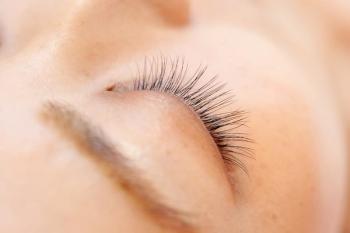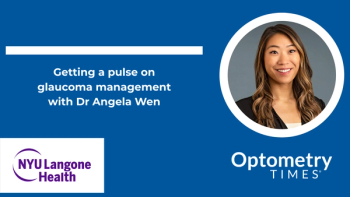
- October digital edition 2020
- Volume 12
- Issue 10
Glaucoma & ocular surface preservation: Key factors for ODs to consider
Know options for treatment are available
Optometrists know glaucoma to be a serious sight-threatening disease and therefore treat it as such. The goal with glaucoma treatment is to slow—and ideally prevent—vision loss. But ODs could do an even better job treating their glaucoma patients by taking into account the effects of glaucoma treatment on the ocular surface. Such consideration has been documented in a case series by Dubrulle et al, showing that when the ocular surface improves by switching patients to preservative-free medications, intraocular pressure (IOP) reduction improved as well.1
Prescribing treatment
Many of the commonly prescribed first- and second-line topical medications used for glaucoma, glaucoma-suspect, and ocular hypertensive patients contain preservatives that may be detrimental to the ocular surface when patients adhere to the treatments prescribed to them.2
This inadvertent iatrogenic effect on the ocular surface can precipitate ocular surface disease. These changes can lead to clinical signs of damage to the corneal and conjunctival surfaces in addition to symptoms which may inevitably lead to a patient’s decreased adherence to the prescribed treatment regimen.
Both the ocular surface damage and the increase in symptoms can complicate the care protocol and contribute to poor IOP management, increasing risk of permanent vision loss. Although these preservatives are commonly found in many topical ocular formulations, when these compounds are used for acute conditions they are commonly used until the issue resolves (think days to weeks). However, IOP-controlling medications are often used for extended periods of time (think years, if not decades).
In addition, medical coverage carriers can make it difficult for ODs to do their jobs. Pharmacy benefits managers determine which medications are on formulary for any given insurance plan, and formularies can frequently change without notice.
If all things were equal, most optometrists’ first choice for therapy would be preservative-free glaucoma medications. But these options are rarely on a preferred tier for most insurance plans, resulting in a higher cost to patients. Often, ODs must show generic options or preferred covered medications have been tried before appealing for tier exemptions on behalf of patients.
Because the hassle of dealing with the prior authorizations and expected pharmacy callbacks for medication substitutions falls on ODs and their staffs, providers may opt to prescribe a generic medication with potentially detrimental preservative side effects in order to get a patient some form of treatment.
Effects of BAK
Speaking of preservatives and their effects on the ocular surface—which preservative is the biggest offender? Benzalkonium chloride (BAK) is by far the most common and the worst for the surface of the eyes.3
This preservative is bactericidal and has surfactant properties. The mechanism of action for BAK is to destroy cell membranes to kill pathogens. While this may sound great, it is an indiscriminate killer. In studies of cell culture models at concentrations of 0.0001% BAK, the arrest of cell growth is noted. At concentrations of 0.01% BAK, cellular apoptosis occurs, and at concentrations of 0.05% to 0.1% BAK, there is cell necrosis.4,5
BAK is especially prevalent in generic ophthalmic formulations. While other ophthalmic drops with different preservatives are available and have been shown to be less toxic than drops containing BAK, you should keep in mind that ultimately the best option is preservative free.2,6
Fortunately, ODs have options—there are a variety of preservative-free medications for IOP control [Table 1].7 There are also manufacturer programs available for preservative-free medications to be direct shipped to patients at a fixed cost. For example, Akorn has created a program called EyeRxDirect in partnership with Eagle Pharmacy in Florida that can provide Zioptan (tafluprost 0.0015%) and Cosopt PF (dorzolamide HCL 2% -timolol maleate 0.5%) for $45 or less for all patients regardless of insurance plan or coverage.
Prostaglandins are still first-line medication therapy for most patients, but some patients cannot manage with preservative-free drops in vials. ODs are able to stay within the category and still move away from a BAK-preserved drop with a newer arrival to the market in Xelpros (latanoprost 0.005%, Sun) which is preserved with potassium sorbate and comes in a standard medication bottle.
Considering options
ODs should reassess what they think of as their first line of treatment while bypassing the potentially adverse effects of repetitively bathing the ocular surface in preservatives. In March 2019, Gazzard et al suggested that selective laser trabeculoplasty (SLT) should be considered a first-line treatment choice for treatment-naive open-angle glaucoma or ocular hypertensive patients. Patients in that study were able to delay topical therapy by at least 3 years.8
Because of this study, we have adjusted our clinical practice and started offering SLT as first-line treatment. In doing so we can avoid, or at least delay, initiating topical medications and the potential for continued exposure of offending preservatives to the ocular surface. Additionally, SLT should also be considered in lieu of adding a second medication when one medication is inadequate in controlling the patient’s glaucoma.
One thing to keep in mind about α-2 agonists is the potential for a delayed hypersensitivity reaction.9 Clinically it presents similar to a viral follicular conjunctivitis. This is worse with higher concentration of brimonidine and apraclonidine (Iopidine, Novartis).10,11 Consider using branded Alphagan-P (0.1% brimonidine tartrate, Allergan, Inc.) which contains a lower concentration of brimonidine and different preservative (Purite vs BAK). This will in turn lead to a lower possibility of an allergic reaction to brimonidine and less irritation to the ocular surface. Once an allergy is developed, α-2 agonists are no longer part of ODs’ armamentarium for treating glaucoma.
Seeing red
What’s the first thing that we typically do when patients complains about irritation or discomfort with their glaucoma medications? I’d like to say it is to switch them to a preservative free option but most of the time the doctor will just recommend an over-the-counter artificial tear.
Some of the preservatives common in artificial tears include BAK (SootheXP, Bausch + Lomb), Polyquad (Systane, Alcon), Purite (Refresh, Allergan). Even though Polyquad and Purite are less toxic than BAK, they still add to the preservative exposure of the ocular surface, furthering the potential for ocular surface disease.12
And for those patients who complain of the redness commonly caused by PGAs or the ocular sequelae of other preserved topical medications? Don’t be surprised to find that they may be reaching for a redness relief drop.
Lumify (0.025% brimonidine, Bausch + Lomb) is a wonderful vasoconstrictor for redness relief that we use as short-term adjunct therapy for allergy patients, but it also contains BAK. Another common drop for redness relief is Visine Max (Johnson & Johnson Consumer). This drop is also preserved with BAK.
The addition of another preservative onto the ocular surface to treat a common side effect of your prescribed therapy may be the tipping point for your patient’s ocular surface. So be sure to ask your patients what they use for their eyes and how often as this may help answer why clinical signs and symptoms are worse at follow up than normally anticipated.
Looking ahead
What’s coming down the pipeline? A company called TearClear is working on a novel device that will be able to remove the preservative in a drop before the drop is delivered onto the ocular surface. If successful, this device will be helpful in opening the door to a preservative-free version of topical glaucoma medications currently available.
Preserved medications for glaucoma will forever be a treatment choice for IOP-challenged patients. Understand that ODs has choices when treating patients, including choices within your drug classes and choices for procedures instead of medications.
Choosing to use preservative-free medications or medications with less offensive preservatives should be considered. Additionally, be sure to ask what other drops a patient may be using for dry eye, allergy, or redness relief.
For optometrists who treat and manage glaucoma in their offices, awareness of patients’ ocular surface can be the key to unlocking successful care for glaucoma patients.
References
1. Dubrulle P, Labbé A, Brasnu E, Liang H, Hamard P, Meziani L, Baudouin C. Influence of Treating Ocular Surface Disease on Intraocular Pressure in Glaucoma Patients Intolerant to Their Topical Treatments: A Report of 10 Cases. J Glaucoma. 2018 Dec;27(12):1105-1111.
2.Anwar Z, Wellik S, Galor A. Glaucoma therapy and ocular surface disease: current literature and recommendations. Curr Opin Ophthalmol. 2013 Mar;24(2):136-43.
3. Noecker R. Effects of common ophthalmic preservatives on ocular health. Adv Ther. 2001 Sep-Oct;18(5):205-15.
4. Gasset AR, Ishii Y, Kaufman HE, Miller T. Cytotoxicity of ophthalmic preservatives. Am J Ophthalmol. 1974 Jul;78(1):98-105.
5. De Saint Jean M, Debbasch C, Brignole F, Rat P, Warnet JM, Baudouin C. Toxicity of preserved and unpreserved antiglaucoma topical drugs in an in vitro mode of conjunctival cells. Curr Eye Res. 2000 Feb;20(2):85-94.
6. Gasset AR, Ishii Y, Kaufman HE, Miller. Cytotoxicity of Ophthalmic Preservatives. Am J Ophthalmology. 1974 July 1;78(1):98-105.
7. Yadgarov A, Garg R. Preservative-Free Alternatives. Glaucoma Today. Available at: https://glaucomatoday.com/articles/2016-nov-dec/preservative-free-alternatives. Accessed 9/14/20.
8. Gazzard G, Konstantakopoulou E, Garway- Heath D, Garg A, Vickerstaff A, Hunter R, Ambler G, Bunce C, Wormald R, Nathwani N, Barton K, Rubin G, Buszewicz M; LiGHT Trial Study Group. Selective laser trabeculoplasty versus eye drops for the first-line treatment of ocular hypertension and glaucoma (LiGHT): a multicentre randomised controlled trial. Lancet. 2019 Apr 13;393(10180):1505-1516.
9. Watts P, Hawksworth N. Delayed hypersensitivity to brimonidine tartrate 0.2% associated with high intraocular pressure. Eye (Lond). 2002 Mar;16(2):132-135.
10. Watts P, Hawksworth N. Delayed hypersensitivity to brimonidine tartrate 0.2% associated with high intraocular pressure. Eye (Lond). 2002 Mar;16(2):132-135.
11. Arthur S, Cantor LB. Update on the role of alpha-agonists in glaucoma management. Exp Eye Res. 2011 Sep;93(3):271-283.
12. Coroi MC, Bungau S, Tit M. Preservatives from the eye drops and the ocular surface. Rom J Ophthalmol. 2015 Jan-Mar;59(1):2-5.
Articles in this issue
about 5 years ago
4 vision-related causes of contact lens discomfortabout 5 years ago
Which patients are poor laser vision correction candidates?about 5 years ago
AI and the modern optometric practice restartabout 5 years ago
When a retinal detachment isn’t a retinal detachmentabout 5 years ago
Where to begin with dry eye technologyabout 5 years ago
Pipeline: Potential new therapy coming for macular diseaseabout 5 years ago
What I have learned from the COVID-19 pandemicNewsletter
Want more insights like this? Subscribe to Optometry Times and get clinical pearls and practice tips delivered straight to your inbox.


















































.png)


